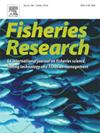Identifying capacity limitations and training needs using a stock assessment game
IF 2.2
2区 农林科学
Q2 FISHERIES
引用次数: 0
Abstract
The technical capability of stock assessment analysts, along with characteristics of their operating environment, often limits the development of suitable population dynamics models and affects the accuracy of estimated quantities used for fisheries management. Following a series of training workshops focused on the Stock Synthesis and Stock Assessment Continuum Tool packages, Australian stock assessment scientists were invited to participate in a hypothetical stock assessment “Game” to explore the repercussions , for assessment, of different levels of experience and technical capability in an informal “consequence-free” manner. A fishery data set was generated using a simulation model that represented a stock distributed over 12 regions and harvested by three fishing fleets. The simulation model was made complex by including spatial structure, time-varying selectivity for some fleets, and changes over time in expected recruitment due to the effects of an environmental driver. The analysts self-organized into six (mostly within-agency) groups and reported estimates of current biomass, current depletion and advice regarding the possibility of local depletion. The results of the Game were used to evaluate the approaches used by the various groups and to identify areas where future training would be most beneficial. The results highlighted opportunities for additional training in spatially-explicit population dynamics modelling, the use of methods for pre-processing monitoring data to select appropriate fleet and population structures, as well as the use of methods to provide values related to growth and natural mortality. The groups treated the Game more seriously than was originally intended by the organizers, with several analysts concerned that any errors or assumptions that were mis-matched with the simulated reality may have brought embarrassment to themselves and their agency. Care should therefore be taken that simulation experiments intending to foster collaboration and learning do so in an explicitly understood risk-free environment. Overall, the Game proved valuable in contributing to the development of an Australian community of practice for stock assessment and identifying how to strengthen assessment capabilities.
求助全文
约1分钟内获得全文
求助全文
来源期刊

Fisheries Research
农林科学-渔业
CiteScore
4.50
自引率
16.70%
发文量
294
审稿时长
15 weeks
期刊介绍:
This journal provides an international forum for the publication of papers in the areas of fisheries science, fishing technology, fisheries management and relevant socio-economics. The scope covers fisheries in salt, brackish and freshwater systems, and all aspects of associated ecology, environmental aspects of fisheries, and economics. Both theoretical and practical papers are acceptable, including laboratory and field experimental studies relevant to fisheries. Papers on the conservation of exploitable living resources are welcome. Review and Viewpoint articles are also published. As the specified areas inevitably impinge on and interrelate with each other, the approach of the journal is multidisciplinary, and authors are encouraged to emphasise the relevance of their own work to that of other disciplines. The journal is intended for fisheries scientists, biological oceanographers, gear technologists, economists, managers, administrators, policy makers and legislators.
 求助内容:
求助内容: 应助结果提醒方式:
应助结果提醒方式:


